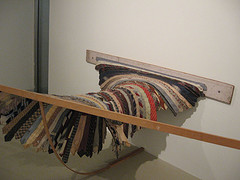
Tie Piece, silk ties and wood
Something the Mind Knows, the John Duff retrospective at the Rosenwald-Wolf Gallery, offers a mix of history and timelessness. I found myself engrossed by the sheer material presence of his post-Minimalist, post surfer-dude sculptures. Some of the work reminded me of aboriginal art. Some of it reminded me of 1950s furniture–those bent iron and fiberglas dinette sets. One piece seemed like a joke on a modernist etagere. Yet the pieces, which expressed great variety, had consistency in their rich formal choices and the wonderful feel for materials.
Duff is not exactly a household name although he has shown at the Whitney nine times, including multiple Whitney Biennials. He also exhibited four times at the Gugenheim, and is represented by the prestigious Knoedler Gallery in New York. Locally, he had a show at Locks Gallery in ’92.
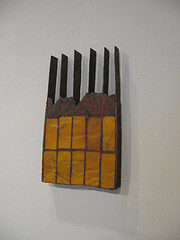
Yellow Wall Piece, resin and wood
I take this show as a continuation of gallery Director Sid Sachs’ exploration of interesting, underappreciated artists, like Rosalyn Drexler and Ree Morton.
Duff’s work, which includes both recent and early pieces, both reflects when it was made, but doesn’t get stuck there.
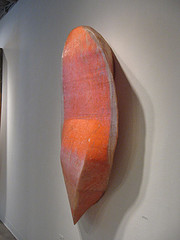
Aleutian Bone, fiberglass and orange enamel paint
Aleutian Bone, made of fiberglass and orange enamel paint, made me think of boomerangs and rugged rock surfaces. (It is one of many fiberglass pieces that show off the artist’s experience building surfboards). The combination of slick and pitted invites touch, and the shape, a sort of humpy shield, calls to mind half-finished Stone Age weapons. At the same time, the reference to Minimalism and Color Field was there for art history to contemplate.
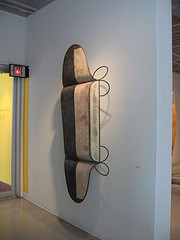
Tipped Shield
At the other extreme, Tipped Shield, looks like the bottom of a sled. The looping tubular steel seems more decorative than functional. And the split black and white coloring calls up escutcheons and primitive face ornamentation.
Another what-is-it of a very different sort is Tie Piece (photo at top of post), a wooden rack that looks rather like a sagging bed draped with ties. But there’s a physical tension, a spring action, that stands in contrast to the droop of the ties. The wry humor here shows up in a number of pieces.
The sculptures–and also some wall drawings by students presented as solutions to a puzzle Duff devised–serve as a reminder of art movements past and art fashions present.
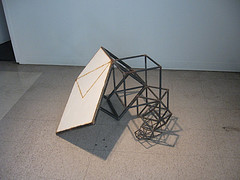
Fractal, 2005, steel and plaster; I love the envelope imagery that suggests a storage space for the smaller shapes.
The light-as-air pieces Fractal and Tetrahedron with Polygon seem to merge the past and present, still capturing the ’50s look of steel-rod-supported furniture at the same time that they tumble across space in carefully planned size ratios. The way they both define empty volumes, the way they both texturize otherwise chilly plaster, and the way they use the plaster planes as antitheses to the outlined, imaginary planes created by the rods, suggest a world where the immaterial and the material have equal weight–they suggest today.
For more images, go to my Flickr set.
R.Crumb keeps on trucking
While I was there, Sachs reminded me that another ’60s dude, R.Crumb, will show his work at Rosenwald-Wolf in February.





